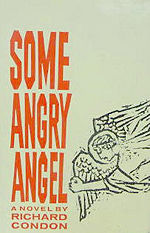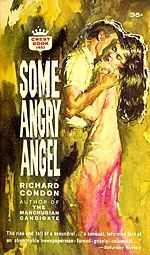Some Angry Angel: A Mid-Century Faerie Tale: Difference between revisions
imported>Hayford Peirce (added second correct image) |
imported>Hayford Peirce (added a paragraph of text -- had better save it before I lose it) |
||
| Line 4: | Line 4: | ||
'''Some Angry Angel''', published in 1960, was [[Richard Condon]]'s third novel and gave impetus to the growing, though relatively short-lived "Condon cult" of that era. Written with all of the panache, stylistic tricks, and mannerisms that characterize all his works, it was not, however, one of his more typical political thrillers such as its immediate predecessor, the far better-known [[The Manchurian Candidate|Manchurian Candidate]]. Although Condon is still remembered today for a number of more action-oriented books such as ''Candidate'', ''[[Winter Kills]]'', and the ''[[Prizzi]]'' series, ''Some Angry Angel'' has long since been forgotten. Its full name is '''Some Angry Angel: A Mid-Century Faerie Tale'''. | '''Some Angry Angel''', published in 1960, was [[Richard Condon]]'s third novel and gave impetus to the growing, though relatively short-lived "Condon cult" of that era. Written with all of the panache, stylistic tricks, and mannerisms that characterize all his works, it was not, however, one of his more typical political thrillers such as its immediate predecessor, the far better-known [[The Manchurian Candidate|Manchurian Candidate]]. Although Condon is still remembered today for a number of more action-oriented books such as ''Candidate'', ''[[Winter Kills]]'', and the ''[[Prizzi]]'' series, ''Some Angry Angel'' has long since been forgotten. Its full name is '''Some Angry Angel: A Mid-Century Faerie Tale'''. | ||
The story of a barely literate New York slum boy, Dan Tiamat, who first works his way up through the newspaper ranks to become America's most famous and most powerful gossip columnist, a role clearly modeled on the 1930s and '40s [[Walter Winchell]], then falls from the heights because of his own character failings to spend the rest of his life as a semi-paralysed Lonelyhearts columnist named Miss Friendship. Although written with Condon's usual panache and mannerisms and laced with moments of black humor, it is also filled with moments of sudden shocking violence and death, generally apparently gratuitous and not invoked by character faults of the victims. As a finishing touch, just when it appears that in spite of all the agony he has undergone for the last ten years or so Dan Tiamat is finally about to reach a triumphant moment of glory, the book ends with a final numbing act of violence. | |||
==Title== | ==Title== | ||
Revision as of 17:31, 20 April 2010
Some Angry Angel, published in 1960, was Richard Condon's third novel and gave impetus to the growing, though relatively short-lived "Condon cult" of that era. Written with all of the panache, stylistic tricks, and mannerisms that characterize all his works, it was not, however, one of his more typical political thrillers such as its immediate predecessor, the far better-known Manchurian Candidate. Although Condon is still remembered today for a number of more action-oriented books such as Candidate, Winter Kills, and the Prizzi series, Some Angry Angel has long since been forgotten. Its full name is Some Angry Angel: A Mid-Century Faerie Tale.
The story of a barely literate New York slum boy, Dan Tiamat, who first works his way up through the newspaper ranks to become America's most famous and most powerful gossip columnist, a role clearly modeled on the 1930s and '40s Walter Winchell, then falls from the heights because of his own character failings to spend the rest of his life as a semi-paralysed Lonelyhearts columnist named Miss Friendship. Although written with Condon's usual panache and mannerisms and laced with moments of black humor, it is also filled with moments of sudden shocking violence and death, generally apparently gratuitous and not invoked by character faults of the victims. As a finishing touch, just when it appears that in spite of all the agony he has undergone for the last ten years or so Dan Tiamat is finally about to reach a triumphant moment of glory, the book ends with a final numbing act of violence.
Title
The title, as is the case in five of Condon's first six books, is derived from the first line of a typical bit of Condonian doggerel that supposedly comes from a fictitious Keener's Manual mentioned in many of his earlier novels:
- Some angry angel,
- Bleared by Bach and too inbred,
- Climbed out of bed,
- And, glancing downward,
- Threw a rock
- Which struck an earthbound peacock's head.
- The peacock fell.
- The peacock's yell,
- Outraged by such treason,
- Cried out to know why it,
- Out of billions,
- Should be hit,
- And instantly invented a reason.
- Some angry angel,
The verse is found in two places: as an epigraph on a blank page five pages after the title page and two pages before the beginning of the text; and, on page 275, as the closing words or coda of the book.[1]
Theme
Characters
Typical Condon quirks and characteristics
References
- ↑ The entire verse is in italics in both places in the book. Some Angry Angel: A Mid-Century Faerie Tale, McGraw-Hill, New York, 1960, Library of Congress Catalog Card Number: 60-8826

